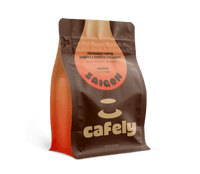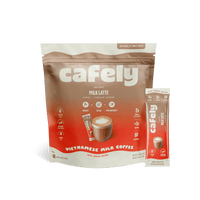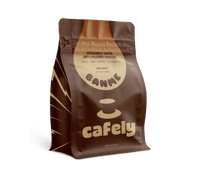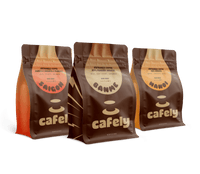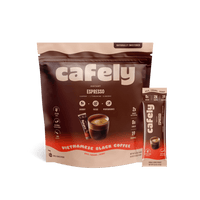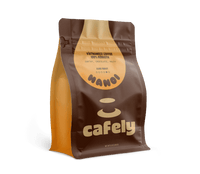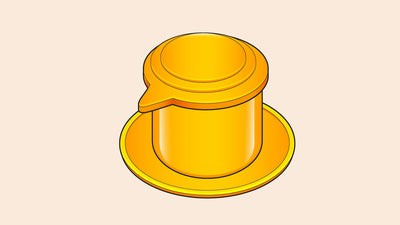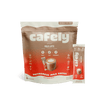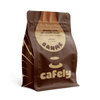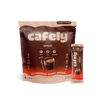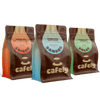If you want to make amazing Vietnamese coffee in the comfort of your home, you need a Vietnamese coffee press, otherwise known as a phin filter.
The phin filter makes a silky smooth yet strong cup of coffee to which you add sweetened condensed milk. Even though it looks intimidating, it’s actually pretty simple to use.
It’s also a sustainable way to get your morning cup of coffee since there are no paper filters. Let’s dive in and find out everything you need to know about the phin.
What is a Phin Filter?

First things first — a phin filter is a small coffee press that’s used to make traditional Vietnamese coffee. It’s kind of similar to a moka pot in many regards, but it’s normally a lot lighter.
It’s made up of four components:
- The filter plate
- The brew chamber
- The gravity press
- The cap or lid
Filter Plate
The filter plate is the part that sits on top of your coffee mug and allows the coffee to drip slowly into your cup. The coffee needs to be a medium-fine grind with this filter.
Brew Chamber
Next up, we move onto the brew chamber, which as the name suggests, is where the coffee and water mix into a delicious brew. You use this chamber in two parts — once to make the coffee bloom and again to fill your cup.
Gravity Press
Some phin filters include a gravity press, which works like a tamper to get the coffee pressed before the water goes in. You don’t need to press down too hard because the pressure from the hot water does that for you.
Cap/Lid
Finally, the cap is used as a lid for the brew chamber to keep the heat in. Once you’ve finished brewing your coffee, some caps can also double up as a coaster.
Why is the Phin So Popular? (Pros & Cons)
The phin filter is a simple immersion-style brewing device. Coffee mixes with water in the brewing chamber to extract the aromatic constituents. The water is then pulled through a filter to remove any particulate as it falls into your cup below.
It takes about 5–6 minutes from start to finish to brew a strong cup of coffee with the phin filter (depending on the size of your device).
Pros & Cons of the Phin Filter:
- ✅ Portable — The phin is small and compact, making it easy to take your coffee on the road.
- ✅ Versatile — The phin is traditionally used to brew robusta coffee, but it works just as well with arabica or liberica coffees.
- ✅ Durable — There’s no glass or ceramic to break. All parts of the phin are made from durable metals which resist the stress of daily use. Even damaged phins are easily repaired with simple tools.
- ✅ Cheap — The phin is very simple and cheap to make. It’s one of the most affordable coffeemakers you can buy.
- ✅ Environmentally-Friendly — Phins have a built-in filter, so no paper waste is created while brewing your coffee.
- ❌ Time-consuming— Brewing with a phin filter doesn’t take too long if you’re making a single cup of coffee. However, it can be a drawback if you need to make multiple cups and don’t have a large enough phin.
- ❌ Strong — A strong cup of coffee isn’t necessarily a negative (we certainly don’t see it as one), but some people prefer theirs to be lighter.
How to Brew Vietnamese Coffee With a Phin: A Step-by-Step Guide

The phin process is pretty simple. You fill the brew chamber with coffee and water, and it slowly drips into the cup below. This is why some people think it’s similar to a moka pot in terms of brewing methods, except a phin is a lot more low maintenance — no stovetops, no waiting for a whistle, and no over-brewing.
Let’s dive into the step-by-step process of using a phin filter to brew Vietnamese coffee. This is for a standard 4 oz phin filter.
If you’re using a larger or smaller phin, adjust the amounts accordingly:
- Heat some water to just below boiling.
- The coffee beans should be a medium-fine grind.
- Place your phin filter on top of your mug.
- Add 2 tablespoons of ground coffee to the brew chamber.
- Tamp down the coffee evenly (not too hard!).
- Add just enough water to cover the gravity press; let the coffee bloom for about 45 seconds.
- Add the remainder of the hot water to fill the chamber just below the top.
- Chill for 4-6 minutes while your coffee drips into your mug.
- Serve and enjoy! Traditional phin coffee is typically served with condensed milk over ice.
Check out our full guide on how to use the phin filter to brew traditional Vietnamese coffee.
Expert Tips & Tricks When Using a Phin Filter

Although using a phin filter is fairly straightforward, there are a few tips and tricks that can make your at-home Vietnamese coffee taste as good as it tastes from a stand in HaNoi.
1. Use the Right Grind Size
The best grind for a phin filter is medium-fine (similar to sand). You don't want it to be too fine as it will clog the filter plate, and too coarse will make the coffee weak and lacking flavor instead of strong and smooth.
2. Choose High-Quality Vietnamese Coffee Beans
A high-quality robusta coffee like our HaNoi beans is critical to making the most authentic cup. Otherwise, use our DaNang robusta/arabica blend for something lighter. If you’re looking for a blend that uses robusta, arabica, and peaberry but still packs a punch, opt for our SaiGon OG, which is roasted with butter to give that classic Vietnamese smooth flavor without sacrificing the caffeine.
There are quite a few differences between robusta and arabica beans, so what you use alters the final cup. If you like a more fruity or chocolate-led, light cup of coffee, then arabica is going to be better for you. However, if you’re looking for a strong, highly-caffeinated coffee that has woody and nutty flavor profiles, you’ll want to opt for a robusta bean.
Phin filters brew short and strong coffees, so if you’re not sure about a punchy coffee, choose an arabica base — the phin filter will make those flavors sing and still give you that caffeine hit. On the other hand, if you love a strong coffee that wakes you up, combining the power of robusta coffee beans and a phin filter is a match made in heaven.
3. Use a Burr Grinder
Grinding your beans at home is the best way to get the freshest cup of coffee. There are plenty of grinders to choose from, and all can do the job, but a burr grinder will give you the most consistent grind.
As stated above, make sure the coffee beans are medium-fine.
4. Check the Water Temperature
It’s easier to throw a pot of water on and guess when it’s hot enough, but you’ll get a tastier cup of coffee if it’s at the right temp — between 190-205ºF (90ºC).
Too cold of water won’t allow for proper extraction, but you don’t want to use boiling water, either — it will give it a burnt taste.
5. Watch the Coffee-Water Ratio
The ideal coffee-to-water ratio is 1:2. This gives the coffee a strong punch without being overwhelming. However, feel free to play around with this. You can make the coffee stronger or weaker if you want.
6. Don’t Forget the Bloom
A "bloom" is an extra step, but it's crucial to give the coffee a smooth and rich flavor. All you do is add an ounce of off-boiling water to your phin, wait for it to trickle through (about a minute), and then add the rest of the water. The taste difference is huge!
Vietnamese Coffee Recipes (Using a Phin Filter)
Want to make a traditional cup of Vietnamese coffee at home? Well, whether you want your java fix to be hot or cold, we’ve got you covered.
Recipe for Hot Vietnamese Coffee
Check out our full guide to brewing Vietnamese coffee here.
Here are the steps simplified for phin users:
- Add 1-3 tablespoons of sweetened condensed milk to your coffee cup.
- Brew four to six ounces of coffee using the phin filter (instructions above) into the cup.
- Give it a quick stir.
- Sit back and enjoy!
Recipe for Iced Vietnamese Coffee
For all of the details, read our guide to making Vietnamese iced coffee.
Here are the basic steps:
- Add 1-3 tablespoons of sweetened condensed milk to a heat-resistant glass cup or mug.
- Brew 4–6 ounces of coffee using the phin filter (instructions above) into the cup.
- Stir and add plenty of ice.
- Sit back and enjoy!
Recipe For Vietnamese Egg Foam Coffee
For something more unique, try making Vietnamese egg foam coffee. The process is the same as it is for traditional iced coffee, but you’ll need to create the sweetened egg foam first.
Here are the basic steps:
- Whisk 2 egg yolks, 3 tablespoons of sweetened condensed milk, and 1 teaspoon of white sugar until it forms a thick, frothy foam.
- Brew 4–6 ounces of coffee using the phin filter (instructions above).
- Stir your egg foam and coffee together, and add plenty of ice.
- Sit back and enjoy!
Recipe For Ube Latte
Ube is a type of purple yam found in Southeast Asia. While this ube latte recipe isn’t exactly traditional, its unique fruity taste and similarities with Vietnamese coffee make it a perfect candidate to apply your newly adopted phin brewing technique.
The sweet flavor and silky texture of ube pairs perfectly with the strong, bold flavors of phin coffee.
Here's how to make it:
- Mix ½ a can of coconut milk with 2 teaspoons of ube extract, 3 ounces of syrup (homemade or storebought work great) and ¼ teaspoon of vanilla extract. Whisk until uniformly mixed.
- Brew 406 ounces of coffee using a phin filter (instructions above).
- Stir your ube syrup with your coffee and pour over ice.
- Sit back and enjoy!
Related: Vietnamese Coconut Coffee Recipe
FAQs: Traditional Vietnamese Phin Filters
Now that you know how to brew Vietnamese coffee using a phin filter, let’s check out a few frequently asked questions.
1. How long does it take to brew coffee with a phin filter?
The brew time using a phin filter largely depends on how much water you use, but it takes 4-6 minutes on average. On the home brewing scale, it takes less time than a moka pot but slightly longer than an Aeropress.
2. What is the ratio of coffee to water when using a phin filter?
The ratio of coffee to water when using a phin filter depends on how strong you want your brew to be, but it’s normally two parts water to one part ground coffee. As you use your phin filter more, you can play around with your ratios until you get the desired brew strength.
3. Do you need a phin for Vietnamese coffee?
You can make Vietnamese coffee without the phin filter, but using one is the authentic and traditional way to do it. It’s also surprisingly low maintenance versus a pour-over, moka pot, or French press, which all need watching with a keen eye to get right. By comparison, you just set up a phin and let it do its thing while you go do your thing.
If you don't have these devices, know that there are also alternative ways of making coffee without a filter, such as using a fine sieve, paper towel, or cheesecloth.
4. What coffee is best for phin filters?
When using a phin filter for a cup of Vietnamese coffee, you’ll need robusta rather than arabica beans. That gives it an authentic, punchy flavor. In terms of grind consistency, you’ll want the beans to be medium-fine. Too fine or too coarse won’t work with a phin filter — the coffee will be over-extracted or too weak.
5. How much does a Phin filter cost?
Phin filters can cost anywhere from $15 to $35+, depending on the quality and brand that you're buying. Stainless steel Phin filters are often more expensive than their aluminum counterparts, but they also retain heat a lot better, which is better for getting that perfect brew!
6. Why isn’t my Phin filter working?
A lot of the time, if your Phin filter isn't working, it's because the filter plate isn't clean enough or it's blocked. Remove it safely (make sure the hot water is cleared out of the way), and give it another clean. If the holes are blocked up, there's nowhere for the delicious coffee to flow through.
Another reason can be that you’ve bought the wrong grind style for your Phin. Medium-fine tends to work best, so if it’s too fine or too coarse, you’re unlikely to get the desired results.
7. Where did the Phin filter come from?
As with a lot of things to do with Vietnamese culture, the origins of the Phin filter stem back to colonialism. The French missionaries and colonizers brought over Phin filters as well as the first coffee plants in the late 1800s. Up until then, Vietnam — like many other Asian nations — had been a tea-drinking country.
8. Can the Phin filter be used with different types of coffee beans?
Yes, you can use different coffee beans with a Phin filter, but for that punchy, authentic Vietnamese coffee flavor, you’ll need Robusta beans, like our HaNoi robusta beans. However, if you don’t have Robusta beans handy, you can always use arabica beans.
Alternatively, you can use a traditional butter-roast coffee like our SaiGon OG roast for the most authentic taste possible.
